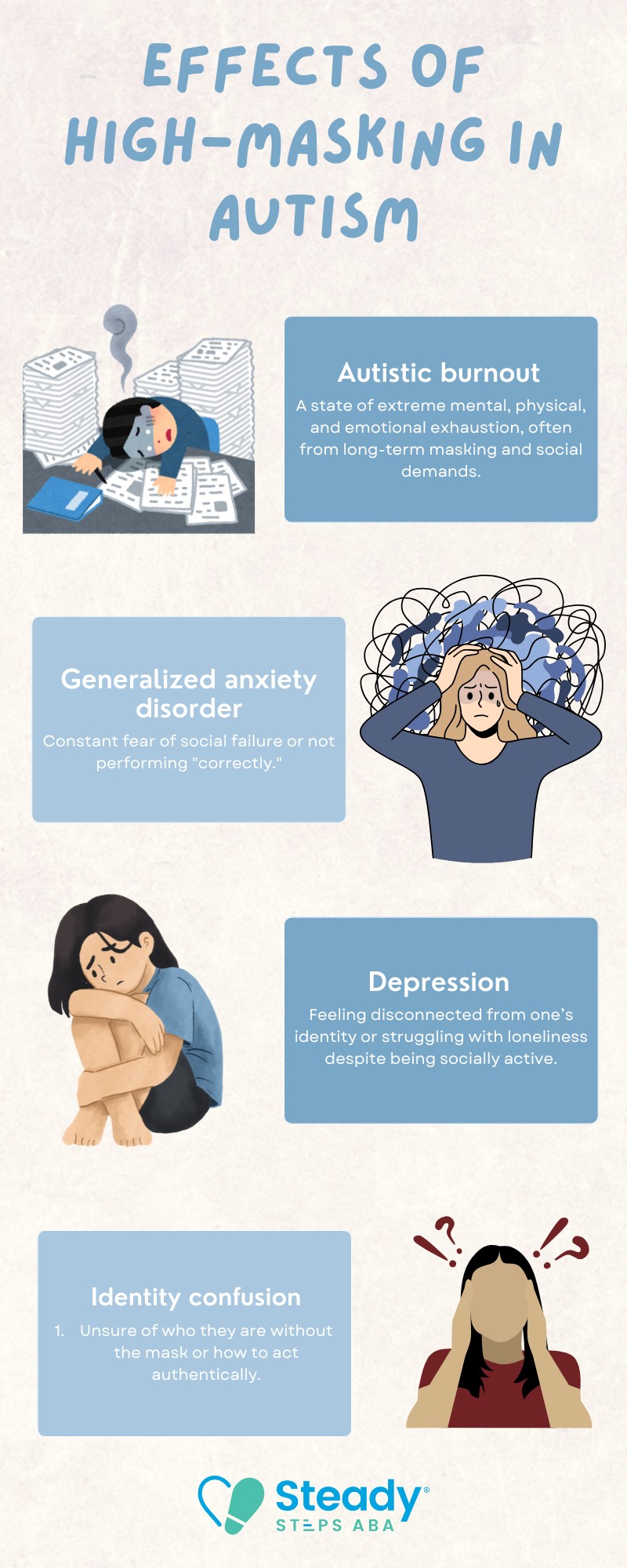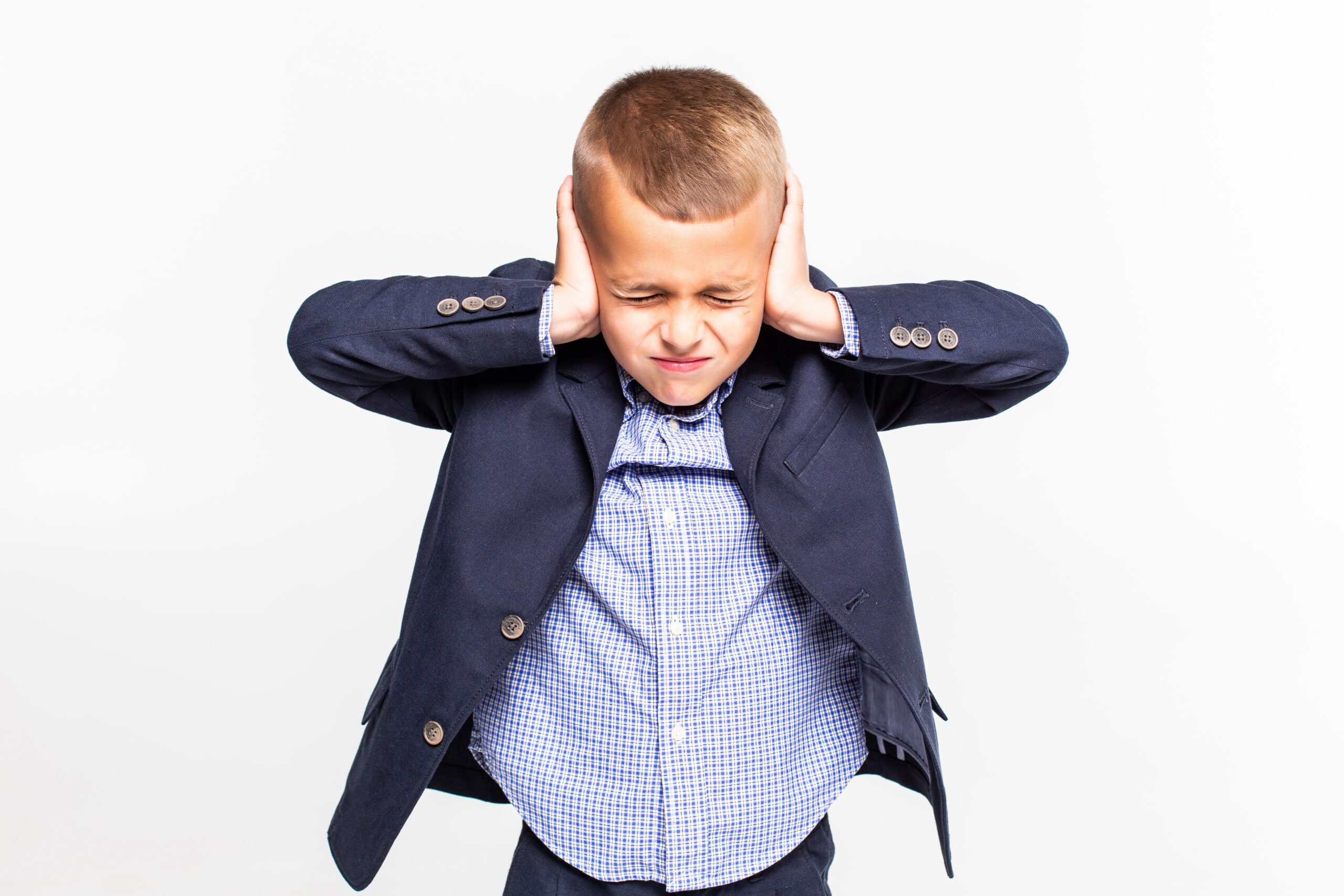Key Points:
- High-masking autism refers to autistic individuals who intentionally or unconsciously hide their traits to fit into neurotypical environments.
- This form of masking can lead to mental and emotional exhaustion, misdiagnosis, and delayed support.
- Early recognition and support, including ABA therapy, can improve emotional well-being and long-term outcomes.
Many autistic individuals go unnoticed because they don’t fit the common stereotypes of autism. This is especially true for those with high-masking autism—a term used to describe people on the spectrum who camouflage their autistic traits to blend into everyday social settings.
According to research, masking may be more common in autistic females, with 90.9% reporting masking behaviors. While this can make someone appear “fine” on the outside, masking often comes at a steep internal cost.
In this article, we’ll unpack what high-masking autism really looks like, why it often leads to late diagnosis, and how it impacts mental health. If you’re a parent, caregiver, or loved one trying to understand this form of autism better, the following insights are designed to offer clarity and real strategies for support.
What Is High-Masking Autism?
High-masking autism refers to individuals on the autism spectrum who hide or suppress their autistic traits in order to appear socially typical. They may mimic social behavior, rehearse responses, or avoid stimming in public—all to avoid standing out or being judged.
This form of masking is often most noticeable in women and nonbinary individuals, though it can affect anyone. People with high-masking autism frequently fly under the radar in schools, workplaces, and even during clinical assessments. Despite seeming “high-functioning,” many experience anxiety, burnout, and identity confusion due to constant self-monitoring.
Why Do People With Autism Mask Their Traits?
People with autism often mask their traits to fit in socially, avoid judgment, or reduce conflict. Masking involves hiding natural behaviors like stimming, mimicking neurotypical social cues, or suppressing emotional responses in public.
This coping strategy may help avoid bullying or misunderstanding, but it can also lead to exhaustion, anxiety, and a loss of identity. Many autistic individuals report that long-term masking affects mental health and can delay access to appropriate support.
Recognizing the pressures behind masking can help families and educators create more accepting, supportive environments where authentic self-expression is safe.
What Are the Signs of High-Masking Autism?
High-masking autism can be difficult to spot, but certain patterns can serve as important clues. These signs often become clearer when viewed in the context of long-term stress or emotional exhaustion.
Look for these indicators:
1. Public Calm, Private Meltdowns
Individuals may appear composed in public but later experience emotional outbursts or shutdowns in private, often due to the effort of suppressing natural responses throughout the day.
2. Burnout After Socializing
After masking through social situations, many feel mentally and physically drained. This chronic exhaustion can lead to burnout, affecting mood, motivation, and overall well-being.
3. Strict Personal Rules
People with high-masking autism may create unspoken rules to appear “normal,” like always smiling, making eye contact, or avoiding stimming, which increases internal stress over time.
4. Rehearsed Speech
Rather than speaking spontaneously, some rely on practiced phrases to navigate conversations, which can feel more like performing than connecting.
5. Delayed Emotions
Feelings may not surface until hours or days after an event, making it hard to link emotions to specific situations and process them appropriately.
6. Fear of Rejection
To avoid being misunderstood or excluded, many become overly cautious, self-critical, or people-pleasing—often hiding their authentic selves out of fear.
7. Hidden Anxiety or Depression
Mental health challenges like anxiety or depression may go undetected due to masking, especially when outward behavior seems controlled or successful.
These signs don’t mean a person is “less autistic.” Instead, they often point to someone working overtime to appear non-autistic, which may delay their path to diagnosis and support.
How Does High-Masking Autism Impact Mental Health?
The effort of hiding one’s true self daily can lead to serious emotional fallout. For many with high-masking autism, the internal pressure builds quietly until it erupts as anxiety, depression, or burnout.
Here are some of the most common mental health impacts:

Without proper recognition and support, these mental health issues can worsen over time. In some cases, they even lead to suicidal thoughts, particularly in individuals who go undiagnosed or unsupported for decades.
Why Is High-Masking Autism Often Misdiagnosed or Overlooked?
High-masking autism is often misdiagnosed or overlooked because outward behaviors can appear socially typical, hiding internal struggles. Many individuals develop coping strategies that conceal their autistic traits, leading professionals to miss the signs or mistake them for anxiety, ADHD, or personality disorders.
This is especially common in women and AFAB individuals, who may mask more consistently due to social pressures. Since diagnostic tools often focus on overt traits, those who internalize or “camouflage” their autism don’t always meet traditional criteria. Without a deeper look into fatigue, emotional shutdowns, or lifelong masking habits, high-masking autism can remain.
How Can You Support Someone With High-Masking Autism?
Support starts with understanding. If someone you love shows signs of masking, they may not need “fixing”—they may need a safe space to be themselves. Encouraging unmasking can reduce stress, improve communication, and strengthen relationships.
Effective strategies include:
1. Validate Their Experience
Acknowledge the emotional exhaustion that comes from masking. Let them know their stress is real and understandable, not exaggerated or “all in their head.”
2. Create a Safe Home
Promote unmasking at home by accepting stims, silence, or alone time without judgment. Authenticity should feel safe, not risky.
3. Protect Their Time
Limit packed schedules and leave room for rest. Social recovery time helps reduce burnout and makes future interactions more manageable.
4. Give Space to Communicate
Be patient when responses feel delayed. People who mask often need more time to process and express genuine thoughts.
5. Nurture Their Passions
Engage with their special interests instead of dismissing them. These can provide relief, stability, and a sense of purpose.
6. Learn Alongside Them
Read or listen to stories from autistic adults. Shared learning builds empathy and removes the pressure of being “the only one.”
Remember, masking often becomes a survival habit. Undoing it takes trust, consistency, and support over time.
Lorem ipsum dolor sit amet, consectetur adipiscing elit. Ut elit tellus, luctus nec ullamcorper mattis, pulvinar dapibus leo.

What Does Unmasking Look Like?
Unmasking means gradually letting go of behaviors used to hide autistic traits in order to feel more authentic. This may involve stimming openly, avoiding eye contact, setting boundaries, or expressing emotions more freely.
Unmasking often leads to increased emotional well-being, reduced anxiety, and deeper connections with others. It takes time, safety, and support—especially from family, friends, and affirming environments that respect neurodivergent expression without forcing change.
Can ABA Therapy Help Adults With High-Masking Autism?
Yes, ABA therapy can help adults with high-masking autism by supporting authentic behavior and reducing stress from constant masking. It focuses on personalized goals that build self-advocacy, emotional regulation, and communication skills.
Modern, neurodiversity-affirming ABA approaches avoid forcing conformity. Instead, they help adults identify needs, express boundaries, and develop coping strategies that align with their values, not just social expectations. When tailored for adults, ABA can promote unmasking in safe, respectful ways that improve long-term well-being.
Foster Growth and Development With ABA Therapy
High-masking autism is often misunderstood, but with awareness and support, individuals can find a healthier path forward. Whether it’s navigating burnout, learning to self-advocate, or letting go of years of masking, the journey to authenticity is one worth taking.
Steady Steps ABA offers individualized ABA therapy in Maryland, designed to support adults and families navigating the complexities of autism, especially those who have spent years masking their traits.
Get in touch with us to learn how our ABA services in Maryland can provide the understanding, tools, and emotional support needed for long-term well-being.






